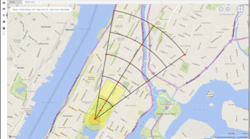RadResponder
More Info on RadResponder
The RadResponder network provides a host of other tools for emergency managers to keep informed. There are videos, repositories of past drills and exercises, training information, factsheets, manuals and more.
Exercises are catalogued in several different ways, using dashboards with charts, graphs and even interactive maps to provide insight for the future. Users can search for past events and view this information in any one of these interactive forms. They can also filter activity down to their own organization to stay updated on their own events, equipment, facilities and personnel.
Radiological response teams around the country have joined RadResponder, able to connect their radiological detection hardware—computers, meters, samplers, etc.—to the network to perform experiments and store data in real time. The network can connect to detectors through Bluetooth equipment, a mobile app or, simply, a radio. State and local governments have used the network to test, plan and train their radiological response teams. RadResponder is also integrated into the Radiological Dispersal Device (RDD) Guidance, providing a science-based tool for responding in the First 100 minutes of an RDD detonation, recently released by DHS S&T, FEMA and DOE NNSA.
Another recent addition to the network was the ability to merge data from different events together—an example of how RadResponder helps give experts a unified picture of radiological response across agencies. The network also recently made the mobile app accessible to a wider range of smartphones, which will allow more robust communication, more data shared between and within organizations in their planning and research.
